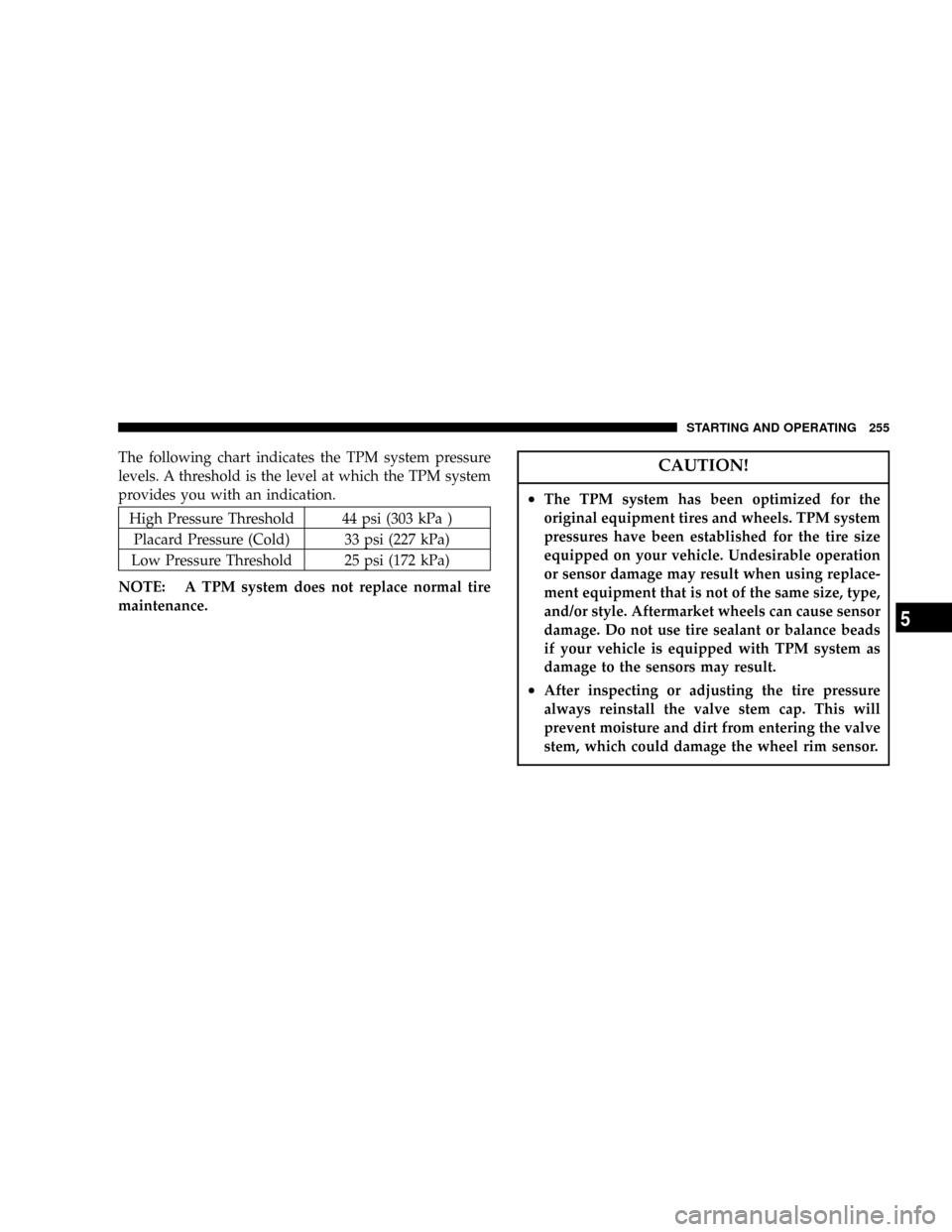Page 245 of 374

4) the cold tire inflation pressures for the front, rear
and spare tires.
Loading
The vehicle maximum load on the tire must not exceed
the load carrying capacity of the tire on your vehicle. You
will not exceed the tire's load carrying capacity if you
adhere to the loading conditions, tire size and cold tire
inflation pressures specified on the Tire and Loading
Information placard and the Vehicle Loading section of
this manual.
NOTE:Under a maximum loaded vehicle condition,
gross axle weight ratings (GAWR's) for the front and rear
axles must not be exceeded. For further information on
GAWR's, vehicle loading and trailer towing, see the
Vehicle Loading section of this manual.To determine the maximum loading conditions of your
vehicle, locate the statement ªThe combined weight of
occupants and cargo should never exceed XXX kg or XXX
lbs.º on the Tire and Loading Information placard. The
combined weight of occupants, cargo/luggage and
trailer tongue weight (if applicable) should never exceed
the weight referenced here.
Steps for Determining Correct Load Limit
1. Locate the statement ªThe combined weight of occu-
pants and cargo should never exceed XXX poundsº on
your vehicle's placard.
2. Determine the combined weight of the driver and
passengers that will be riding in your vehicle.
STARTING AND OPERATING 245
5
Page 248 of 374

WARNING!
Overloading of your tire is dangerous. Overloading
can cause tire failure, affect vehicle handling, and
increase your stopping distance. Use tires of the
recommended load capacity for your vehicle. Never
overload them.
TIRES Ð GENERAL INFORMATION
Proper tire inflation pressure is essential to the safe and
satisfactory operation of your vehicle. Three primary
areas are affected by improper tire pressure:1. SafetyÐ
WARNING!
Improperly inflated tires are dangerous and can
cause accidents.
²Under inflation increases tire flexing and can
result in tire failure.
²Over inflation reduces a tire's ability to cushion
shock. Objects on the road and chuck holes can cause
damage that results in tire failure.
²Unequal tire pressures can cause steering prob-
lems. You could lose control of your vehicle.
²Overinflated or under inflated tires can affect
vehicle handling and can fail suddenly, resulting in
loss of vehicle control.
Always drive with each tire inflated to the recom-
mended pressure.
248 STARTING AND OPERATING
Page 250 of 374

The tire pressure should be checked and adjusted at least
once every month. Check more often if subject to a wide
range of outdoor temperatures, as tire pressures vary
with temperature changes.
Inflation pressures specified on the label are always
ªCold Inflation Pressure.º Cold inflation pressure is
defined as the tire pressure after the vehicle has been idle
for at least 3 hours, or driven less than a mile after a 3
hour period. The cold inflation pressure must not exceed
the maximum values molded into the tire sidewall.
Tire pressures may increase from 13 to 40 kPa (2 to 6 psi)
[0.138 to 0.414 bar] during operation. DO NOT reduce
this normal pressure buildup.High Speed Operation
WARNING!
High speed driving with your vehicle under load is
dangerous. The added strain on your tires could
cause them to fail. You could have a serious accident.
Don't drive a vehicle loaded to maximum capacity at
continuous speeds above 75 mph (120 km/h).
The manufacturer advocates driving at safe speeds
within posted speed limits. Where speed limits or condi-
tions are such that the vehicle can be driven at high
speeds, correct tire inflation pressure is very important.
250 STARTING AND OPERATING
Page 251 of 374
Radial-Ply Tires
WARNING!
Combining radial ply tires with other types of tires
on your vehicle will cause your vehicle to handle
poorly. The instability could cause an accident. Al-
ways use radial tires in sets of four. Never combine
them with other types of tires.
Cuts and punctures in radial tires are repairable only in
the tread area because of sidewall flexing. Consult your
dealer for radial tire repairs.
Tire Spinning
When stuck in mud, sand, snow, or ice conditions, do not
spin your vehicle's wheels above 35 mph (55 km/h).
WARNING!
Fast spinning tires can be dangerous. Forces gener-
ated by excessive wheel speeds may cause tire dam-
age or failure. A tire could explode and injure
someone. Do not spin your vehicle's wheels faster
than 35 mph (55 km/h) when you are stuck. And
don't let anyone near a spinning wheel, no matter
what the speed.
STARTING AND OPERATING 251
5
Page 252 of 374
Tread Wear Indicators
These indicators are narrow strips 1/16 inch (1.6 mm)
thick and are found in the tread pattern grooves.
When the tread pattern is worn down to these treadwear
indicators, the tires should be replaced.
Overloading your vehicle, long trips in very hot weather,
and driving on bad roads may result in greater wear.
Replacement Tires
The tires on your new vehicle provide a balance of many
characteristics. They should be inspected regularly for
wear and correct inflation pressure. The manufacture
strongly recommends that you use tires equivalent to the
originals in quality and performance when replacement
is needed (see section on tread wear indicators). Failure
to use equivalent replacement tires may adversely affect
the safety, handling, ride and fuel economy of your
vehicle. We recommend that you contact your original
equipment tire dealer on any questions you may have on
tire specifications or capability.
252 STARTING AND OPERATING
Page 253 of 374

WARNING!
²Do not use a tire, wheel size or rating other than that
specified for your vehicle. Some combinations of unap-
proved tires and wheels may change suspension dimen-
sions and performance characteristics, resulting in
changes to steering, handling, and braking of your
vehicle. This can cause unpredictable handling and
stress to steering and suspension components. You
could lose control and have an accident resulting in
serious injury or death. Use only the tire and wheel
sizes with load ratings approved for your vehicle.
²Never use a tire smaller than the minimum tire size
listed on your vehicle's tire label. Using a smaller tire
could result in tire overloading and failure. You could
lose control and have an accident.
²Failure to equip your vehicle with tires having adequate
speed capability can result in sudden tire failure and
loss of vehicle control.
²Overloading your tires is dangerous. Overloading can
cause tire failure. Use tires of the recommended load
capacity for your vehicle - never overload them.
CAUTION!
Replacing original tires with tires of a different size
may result in false speedometer and odometer read-
ings. Check with your dealer before replacing tires
with a different size.
Alignment and Balance
The suspension components of your vehicle should be
inspected and aligned when needed, to obtain maximum
tire tread life.
Poor suspension alignment may result in:
²reduced tread life;
²uneven tire wear, such as feathering and one-sided
wear;
²vehicle pull to the right or to the left.
STARTING AND OPERATING 253
5
Page 254 of 374

Tires may also cause the vehicle to pull left or right.
Alignment will not correct this problem. See your dealer
for proper diagnosis of the problem.
Improper alignment will not normally cause vehicle
vibration, which may be a result of tire and wheel
out-of-balance. Proper balancing will reduce vibration
and avoid tire cupping and spotty wear.
TIRE PRESSURE MONITOR SYSTEM Ð IF
EQUIPPED
The Tire Pressure Monitor System (TPM) monitors the
pressure in all 4 road tires and the full size spare. The
TPM system uses wireless technology to monitor tire
pressure levels. Sensors, mounted to each wheel as part
of the valve stem, transmit tire pressure readings to a
receiver located in the overhead console. The tire pres-
sure status is shown in the Electronic Vehicle Information
Center (EVIC) display. Refer to ªOverhead Consoleº inSection 3 for more information. The TPM system func-
tions even when the EVIC is not set on the tire pressure
display screen.
The TPM system informs you of a low or high tire
pressure condition. If this occurs, correct your tire infla-
tion pressure as soon as possible, and inspect all of your
tires. Be sure to use a high quality gauge when adjusting
pressure. The TPM system is designed to monitor your
tire pressure but will not function as a tire pressure
gauge. There will be a delay between the instant you
adjust the air pressure in a tire and when the system
updates the display. The TPM system is not intended to
provide you with notification of rapid air loss.
254 STARTING AND OPERATING
Page 255 of 374

The following chart indicates the TPM system pressure
levels. A threshold is the level at which the TPM system
provides you with an indication.
High Pressure Threshold 44 psi (303 kPa )
Placard Pressure (Cold) 33 psi (227 kPa)
Low Pressure Threshold 25 psi (172 kPa)
NOTE: A TPM system does not replace normal tire
maintenance.
CAUTION!
²The TPM system has been optimized for the
original equipment tires and wheels. TPM system
pressures have been established for the tire size
equipped on your vehicle. Undesirable operation
or sensor damage may result when using replace-
ment equipment that is not of the same size, type,
and/or style. Aftermarket wheels can cause sensor
damage. Do not use tire sealant or balance beads
if your vehicle is equipped with TPM system as
damage to the sensors may result.
²After inspecting or adjusting the tire pressure
always reinstall the valve stem cap. This will
prevent moisture and dirt from entering the valve
stem, which could damage the wheel rim sensor.
STARTING AND OPERATING 255
5